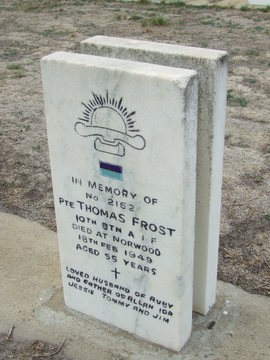
27708
FROST, Thomas
| Service Number: | 2152 |
|---|---|
| Enlisted: | 1 March 1915, at Keswick |
| Last Rank: | Private |
| Last Unit: | 10th Infantry Battalion |
| Born: | Essex, England, 1891 |
| Home Town: | Not yet discovered |
| Schooling: | Not yet discovered |
| Occupation: | Fitter |
| Died: | Norwood, South Australia, Australia, 18 February 1949, cause of death not yet discovered |
| Cemetery: | Not yet discovered |
| Memorials: |
World War 1 Service
| 1 Mar 1915: | Enlisted AIF WW1, Private, 2152, 10th Infantry Battalion, at Keswick | |
|---|---|---|
| 23 Jun 1915: | Involvement Private, 2152, 10th Infantry Battalion, --- :embarkation_roll: roll_number: '10' embarkation_place: Adelaide embarkation_ship: HMAT Borda embarkation_ship_number: A30 public_note: '' | |
| 23 Jun 1915: | Embarked Private, 2152, 10th Infantry Battalion, HMAT Borda, Adelaide | |
| Date unknown: | Wounded 2152, 10th Infantry Battalion |
Help us honour Thomas Frost's service by contributing information, stories, and images so that they can be preserved for future generations.
Add my storyBiography contributed by St Ignatius' College
Thomas frost was born in Essex, England in 1891 or early 1892. Eventually, he moved to South Australia prior to his registration and became an apprentice. He became a Fitter, who are responsible for constructing structural components of machines and assembling them. His next of kin was listed as his sister Ada Mc Leod who lived in London, England at the time of his registration. This potentially means that his parents had passed before the time of enlistment. Thomas enlisted in the army on the first of March 1915 at the Keswick Barracks in South Australia at the age of 23.
Frost began his training at Mitcham Army camp. He had a small frame standing just under 5’6 and weighing only 132lbs (60kg), so we can assume he was not muscular. He trained at the Mitcham army camp for 3 months and 22 days before embarking on the 23rd of June 1915 for Alexandria, Egypt to continue his training. They traveled aboard the HMAT A30 Borda. He trained in Egypt for a further 1 month and 9 days before departing for the Dardanelles on the 1st of August
Thomas was taken on strength in Gallipoli on the 4th of August 1915. The combat became trench warfare and they were at a stalemate. Disease began to spread increasingly fast among the troops, as keeping good sanitation became impossible. Diseases included Malaria, Typhoid, tetanus, septic wounds, and the rapid spread of Dysentery. More than 600 Australian soldiers died to disease and many more became casualties.
Thomas Frost became a victim of typhoid fever. Typhoid fever is a disease spread through contaminated food and water. The symptoms include prolonged fever, sweating, severe headache, abdominal pain, diarrhea or constipation, and lack of appetite and weight loss. Typhoid can be prevented through good sanitation and only drinking boiled or bottled water. However, this would be extremely difficult as the front lines had minimal access to water let alone treated water. Typhoid could also be spread between soldiers resulting in many infections in the overcrowded trenches. Left untreated typhoid could very well be fatal.
On August 29th, 1915 Thomas frost was admitted to the hospital for Diarrhoea. He was later transferred to Moudros, a town on the nearby Greek island of Limnos. He arrived there and was admitted on the 2nd of September. He embarked once again and arrive in Malta where he was admitted to a Military hospital. 5 days later he embarked for England and arrived in London on the 16th of September where he was admitted to the hospital. He spent the next 3 months and 27 days in London. On the 16th of January 1916 embarked for Egypt, he landed on the 23rd and was once again admitted. He then transferred to Cairo where he stayed for several days before finally embarking for Australia for discharge, as he had suffered blindness in one eye and was now medically unfit.
Frost was discharged from the AIF on 28 January 1916. He received the 1914/15 Star, the Victory Medal and the British War Medal.









